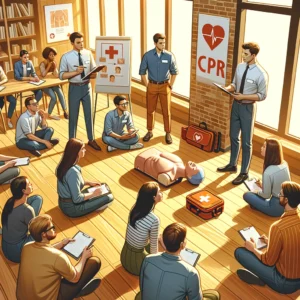 Cardiopulmonary resuscitation (CPR) is a vital skill that everyone should learn, especially those residing in Long Beach, where emergencies can happen anywhere, from the beachfront to bustling city streets. Knowing how to perform CPR can mean the difference between life and death in critical situations. In this guide, we’ll walk you through the step-by-step process of CPR, tailored specifically for Long Beach residents.
Cardiopulmonary resuscitation (CPR) is a vital skill that everyone should learn, especially those residing in Long Beach, where emergencies can happen anywhere, from the beachfront to bustling city streets. Knowing how to perform CPR can mean the difference between life and death in critical situations. In this guide, we’ll walk you through the step-by-step process of CPR, tailored specifically for Long Beach residents.
Step 1: Assess the Situation Before diving into CPR, it’s crucial to ensure the scene is safe for both you and the victim. Look around for any potential hazards, such as traffic, fire, or unstable structures. Call for emergency medical services (EMS) by dialing 911 or instruct someone else to do so. If the area is safe, approach the victim and assess their responsiveness.
Step 2: Check for Responsiveness Gently tap the victim’s shoulder and shout, “Are you okay?” If there’s no response, check for signs of breathing by looking, listening, and feeling for breaths. Place your ear near the victim’s mouth while observing their chest for any rise and fall. If the victim is not breathing or only gasping, they need immediate CPR.
Step 3: Perform Chest Compressions Position the victim on their back on a firm surface. Kneel beside them, ensuring their chest is exposed. Place the heel of one hand on the center of the victim’s chest, slightly below the nipple line. Interlock your fingers and keep your arms straight. Perform chest compressions by pushing down firmly and quickly at a rate of 100 to 120 compressions per minute. Allow the chest to fully recoil between compressions.
Step 4: Deliver Rescue Breaths After 30 compressions, open the victim’s airway by tilting their head back and lifting their chin. Pinch the victim’s nose shut with your fingers and create a seal over their mouth with your mouth. Give two rescue breaths, each lasting about one second and causing the victim’s chest to rise. Ensure that you see the chest fall between breaths.
Step 5: Continue CPR Alternate between chest compressions and rescue breaths in a ratio of 30:2. Continue CPR until emergency medical help arrives or the victim shows signs of life, such as breathing or movement. If another trained individual is present, you can switch roles every two minutes to prevent fatigue.
Step 6: Use an Automated External Defibrillator (AED) If an AED is available, turn it on and follow the prompts. Apply the AED pads to the victim’s bare chest as indicated by the device. Ensure no one is touching the victim during analysis and shock delivery. If a shock is advised, make sure everyone is clear before pressing the shock button. Resume CPR immediately after the shock is delivered, following the device’s instructions.
Step 7: Continue Monitoring and Supporting the Victim Stay with the victim until EMS arrives and takes over. Provide reassurance and support to bystanders, especially if they are family members or friends of the victim. Communicate relevant information to EMS personnel, such as the victim’s condition and any interventions performed.
Step 8: Reflect and Prepare After the situation has been resolved, take a moment to reflect on the experience. Consider enrolling in a CPR certification course to enhance your skills and confidence in handling emergencies. Keep emergency contact numbers handy and familiarize yourself with the locations of nearby AEDs in Long Beach.
Step 9: Spread Awareness Share your CPR knowledge with friends, family, and colleagues. Encourage them to learn CPR and become certified. By empowering more people with CPR skills, you’re increasing the chances of survival for victims of cardiac arrest in Long Beach and beyond.
In conclusion, knowing how to perform CPR is a crucial skill for Long Beach residents to possess. By following these step-by-step instructions and staying calm under pressure, you can make a significant difference in saving someone’s life during a cardiac emergency. Remember, every second counts, so don’t hesitate to take action and be prepared to act swiftly and confidently when needed.